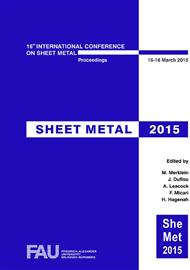[1]
Ahmetoglu.M., Altan.T., Tube hydroforming: state-of-the-art and future trends, Journal of materials Processing Technology, 98 (2000) 25-33.
DOI: 10.1016/s0924-0136(99)00302-7
Google Scholar
[2]
Kridli G.T., Bao.L., Mallick P-K., Tian.Y., Investigation of thickness variation and corner filling in tube hydroforming, Journal of Materials Processing Technology, 33 (2003) 287-296.
DOI: 10.1016/s0924-0136(02)01004-x
Google Scholar
[3]
Hwang Y.M., Chen W-C., Analysis of tube hydroforming in a square cross-sectional die, International Journal of Plasticity, 21 (2005) 1815-1833.
DOI: 10.1016/j.ijplas.2004.09.004
Google Scholar
[4]
Chen K.K., The effects of friction on bursting of tubes in corner filling. SAE Technical Paper Series, 2003-01-0688.
DOI: 10.4271/2003-01-0688
Google Scholar
[5]
Yi H.K., Yim H.S., Lee G.Y., Lee S.M., Chung G.S., Moon Y.H., Experimental investigation of friction coefficient in tube hydroforming, Journal of Transactions of Nonferrous Metals Society of China, 21 (2011) 194–198.
DOI: 10.1016/s1003-6326(11)61087-x
Google Scholar
[6]
Vollertsen F., Plancak M., On possibilities for the determination of the coefficient of friction in hydroforming of tubes, Journal of materials Processing Technology, 125-126 (2002) 412-420.
DOI: 10.1016/s0924-0136(02)00292-3
Google Scholar
[7]
Plancak M., Vollertssen F., Woitschig J., Analysis finite element simulation and experimental investigation of friction in tube hydroforming, Journal of Materials Processing Technology, 170 (2005) 220–228.
DOI: 10.1016/j.jmatprotec.2005.04.109
Google Scholar
[8]
Sun.Z. C., Debray K., Li Y. M., Guo Y. Q., Design-modeling optimization of addendum surface in deep drawing. In Proceeding of the First International Conference of New Forming Technology, (2004) 271-276.
Google Scholar
[9]
Orban H., Hu S.J., Analytical modeling of wall thinning during corner filling in structural tube hydroforming, Journal of Materials Processing Technology, 194 (2007) 7–14.
DOI: 10.1016/j.jmatprotec.2007.03.112
Google Scholar
[10]
Xu X., Li S., Zhang W., Lin Z., Analysis of thickness distribution of square-sectional hydroformed parts, Journal of Materials Processing Technology, 209 (2009) 158–164.
DOI: 10.1016/j.jmatprotec.2008.01.034
Google Scholar
[11]
Zribi T., Khalfallah A., Belhadjsalah H., Analyse de l'effet des paramètres matériaux sur 'hydroformage des tubes. Congrès Tunisien de Mécanique, Hammamet, Tunisie (2008).
Google Scholar
[12]
J.O. Hallquist, LS-DYNA3D User Manual v970, LSTC, Livermore, (1989).
Google Scholar
[13]
N. Boudeau, P. Malécot, A simplified analytical model for post-processing experimental results from tube bulging test: Theory, experimentations, simulations, International Journal of Mechanical Sciences, 65 (2012) 1-11.
DOI: 10.1016/j.ijmecsci.2012.08.002
Google Scholar


